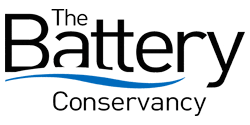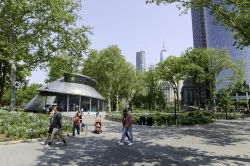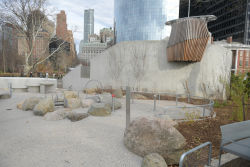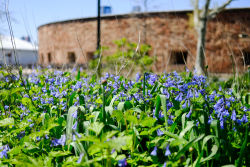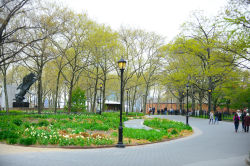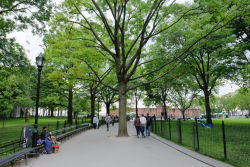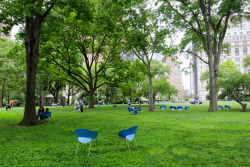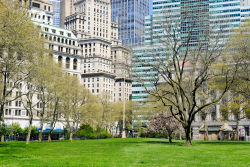The Battery
View all monuments in NYC Parks, as well as temporary public art installations on our NYC Public Art Map and Guide.
Netherland Monument
| Artist: | H.A. Van den Eyden |
| Dedicated: | December 6, 1926 |
| Location: | Northeast entrance near intersection of State Street and Battery Place |
Artwork History
This monumental flagstaff commemorates the Dutch establishment of New Amsterdam and the seventeenth century European settlement which launched the modern metropolis of New York City. Designed by H.A.van den Eijnde (1869-1939), a sculptor from Haarlem in the Netherlands, the monument was dedicated in 1926 to mark the tercentenary of Dutch settlement, and the purchase of the island of Manhattan from Native Americans.
In 1609, the Dutch East India Company ship De Halve Maen (The Half Moon) entered the harbor. The river still carries the name of the ship’s commander, an Englishman named Henry Hudson. Subsequent trading missions led to the formation in 1614 of the New Netherland Company which stretched from Delaware to Connecticut. In 1621, the States General of the Netherlands established the Dutch West India Company. Around this time, Dutch and Walloon families formed a small community at the southern end of the island, though the precise date and circumstances of New Amsterdam’s creation remain the subject of debate. Also in question is the location of the almost mythical purchase of the land now known as Manhattan by Dutch provincial Director General Peter Minuit from the Lenape people, an event depicted on the south-west façade of the monument.
New Amsterdam grew in size and prosperity over the ensuing decades, and became its own municipality in 1653—the same year that a fortification wall was built between the Hudson and East Rivers at what is now Wall Street. This wall was built to defend against an invasion from New England during the First Anglo-Dutch war. Opposite today’s monument site, and the present-day location of the National Museum of the American Indian (formerly the Old Custom House), stood Fort Amsterdam. The waters of the harbor lapped at a shoreline, which has been extended repeatedly over the past three centuries. New Amsterdam was surrendered to the British in 1664 and renamed New York.
Though comprising about three tenths of one percent of the citizenry in the year 2000, the Dutch have had far-reaching influence on local culture. Two boroughs—the Bronx and Brooklyn (Breuckelen)—numerous streets, and the New York Knickerbockers professional basketball team derive their names from the Dutch. Old Dutch-style Houses such as the Dyckman Farmhouse (circa 1785) in northern Manhattan and the Wyckoff House (circa 1652) in Flatbush, Brooklyn survive a bygone era. Monuments to the Dutch legacy dot the landscape, and include Gertrude Vanderbilt Whitney’s statue of Dutch director general Peter Stuyvesant, commissioned for the 1939 New York World’s Fair, which has stood on the western side of Stuyvesant Square Park since 1941. Above all, New York City’s preeminence in commerce is a direct outgrowth of its origins as a Dutch mercantile trading outpost.
On Saint Nicholas Day, December 6, 1926 the Netherlands Monument, a gift of the people of Holland, was formally accepted by Mayor James J. Walker and Parks Commissioner Francis D. Gallatin. At that time it stood south of Castle Clinton, then the site of the New York Aquarium. In 1939 the monument underwent restoration and the inscriptions were recut. Subsequently, a fire caused damage to the monument. When the park was closed from 1940 to 1952 for renovations and to build the Brooklyn-Battery Tunnel, the monument was relocated to its present site at the northeast entrance.
In 2000 the monument was conserved by the City Parks Foundation Monuments Conservation Program, with the financial support of individual and corporate donors under the auspices of the Netherlands Memorial Foundation and the Netherlands Consulate General. The stone was cleaned and poulticed. Bronze emblems were cleaned, repainted, and coated. The map of New Amsterdam was polished, and the Dutch and English inscriptions were repaired and regilded. A new flagstaff will be installed by the City of New York.
The monument was rededicated by the Honorable Pieter van Vollenhoven, Parks Commissioner Stern, and other dignitaries in a ceremony held on November 16, 2000. The date marks Dutch-American Heritage Day, which commemorates the Dutch people’s first salute in 1776 of the United States flag on the Caribbean island of St. Eustatius. The restored monument remains a symbol of the longstanding Dutch presence in American life.
This monument is partially inaccessible due to construction.
Artwork Details
| Description: | Sculpted flagstaff pedestal |
| Materials: | Bencha granite, bronze |
| Dimensions: | Total H: 12'; Top W: 2'6" D: 2'6"; Bottom W: 7' D: 7' |
| Donor: | People of the Netherlands |
| Cast: | 1926 |
Inscription
1) west side: "ON THE / 22ND OF APRIL 1625 / AMSTERDAM CHAMBER OF / THE WEST INDIES COMPANY / DECREED THE ESTABLISHMENT / AND THE CREATION OF THE / ADJOINING FARMS / THE PURCHASE OF THE / ISLAND OF MANHATTAN / WAS ACCOMPLISHED IN / 1626. THUS WAS LAID THE / FOUNDATION OF THE / CITY OF NEW YORK."2) front: "IN TESTIMONY OF ANCIENT AND / UNBROKEN FRIENDSHIP THIS FLAGPOLE / IS PRESENTED TO THE CITY OF NEW YORK / BY THE DUTCH PEOPLE / 1926"
Please note, the NAME field includes a primary designation as well as alternate namingsoften in common or popular usage. The DEDICATED field refers to the most recent dedication, most often, butnot necessarily the original dedication date. If the monument did not have a formal dedication, the yearlisted reflects the date of installation.
For more information, please contact Art & Antiquities at (212) 360-8163.
Check out your park's Vital Signs
Clean & Safe
Green & Resilient
Empowered & Engaged Users
Share your feedback or learn more about how this park is part of a
Vital Park System

Know Before You Go







